It’s almost time for the school year to end and summer reading to begin. Encourage students to head to their local library and sign up for a summer reading program. Here are just a few of the new fiction and nonfiction books recommended to jump-start students’ summer reading.
Ages 4–8
Chuck and Woodchuck. Cece Bell. 2016. Candlewick.
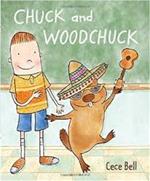 When first-grader Chuck brings his pet Woodchuck for show-and-tell, everyone is delighted and agrees Woodchuck should come to school every day. Woodchuck is especially kind to Caroline, and helps shy Chuck and Caroline become friends by the end of the school year. Young children will connect with this story, illustrated with humorous ink and digitally colored cartoon art, about making friends, which can take some time and require intervention by a friendly third party (such as Woodchuck).
When first-grader Chuck brings his pet Woodchuck for show-and-tell, everyone is delighted and agrees Woodchuck should come to school every day. Woodchuck is especially kind to Caroline, and helps shy Chuck and Caroline become friends by the end of the school year. Young children will connect with this story, illustrated with humorous ink and digitally colored cartoon art, about making friends, which can take some time and require intervention by a friendly third party (such as Woodchuck).
I Won a What? Audrey Vernick. Ill. Robert Neubecker. 2016. Alfred A. Knopf/Random House.
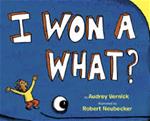 Imagine going to a carnival and winning not a goldfish but a whale! That’s exactly what happens in this story when a young child throws his ping-pong ball into a fish bowl and comes away with Nuncio, a whale. Will the boy’s parents allow him to keep Nuncio? How can they accommodate such an enormous pet? Computer-generated cartoon art in vivid colors makes this humorous book a great spring-into-summer read.
Imagine going to a carnival and winning not a goldfish but a whale! That’s exactly what happens in this story when a young child throws his ping-pong ball into a fish bowl and comes away with Nuncio, a whale. Will the boy’s parents allow him to keep Nuncio? How can they accommodate such an enormous pet? Computer-generated cartoon art in vivid colors makes this humorous book a great spring-into-summer read.
Long Road to Freedom (Ranger in Time#3). Kate Messner. Ill. Kelley McMorris. 2016. Scholastic.
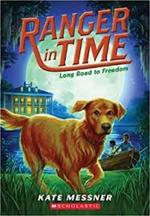 This third book in Messner’s popular series takes time-traveling Ranger, a search-and-rescue golden retriever, to a plantation in Maryland in the mid-1800s, where he helps two slave children make a daring escape and assists them on their journey North. Messner tackles an important topic with just the right amount of danger and suspense for the intended audience. Her detailed research adds a layer of authenticity to the story, and young readers who want to learn more about this time period will be interested in her research notes, suggestions for further reading, and sources. A full-page black-and-white drawing in each chapter adds interest. This book is a good pick for history buffs, dog lovers, and fans of time travel.
This third book in Messner’s popular series takes time-traveling Ranger, a search-and-rescue golden retriever, to a plantation in Maryland in the mid-1800s, where he helps two slave children make a daring escape and assists them on their journey North. Messner tackles an important topic with just the right amount of danger and suspense for the intended audience. Her detailed research adds a layer of authenticity to the story, and young readers who want to learn more about this time period will be interested in her research notes, suggestions for further reading, and sources. A full-page black-and-white drawing in each chapter adds interest. This book is a good pick for history buffs, dog lovers, and fans of time travel.
Oh No, Astro! Matt Roeser. Ill. Brad Woodard. 2016. Simon & Schuster.
 Astro the Asteroid is just trying to keep to himself out in space. When a wayward satellite knocks him off course, Astro finds himself hurtling through space and heading toward Earth at breakneck speed. Vivid computer-designed illustrations in red, blue, yellow, black, and white create a cohesive feel to this picture book. Additional space facts at the end of the story are a perfect entry into some follow-up nonfiction space stories for young readers.
Astro the Asteroid is just trying to keep to himself out in space. When a wayward satellite knocks him off course, Astro finds himself hurtling through space and heading toward Earth at breakneck speed. Vivid computer-designed illustrations in red, blue, yellow, black, and white create a cohesive feel to this picture book. Additional space facts at the end of the story are a perfect entry into some follow-up nonfiction space stories for young readers.
Ages 9–11
Anything but Ordinary Addie: The True Story of Adelaide Herrmann, Queen of Magic. Mara Rockliff. Ill. Iacopo Bruno. Candlewick.
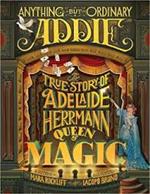 This picture book biography tells the story of Adelaide Herrmann (1853–1932), the first (and one of the only ever) known woman magician. From a young age, Addie wasn’t one who accepted the idea girls couldn’t do certain things, and she explored many new and adventurous opportunities before marrying magician Alexander Herrmann. Bruno’s pencil and digitally colored illustrations dramatically (and literally) set the stage for this entertaining biography. When her husband dies unexpectedly, Addie decides that the show must go on, and she performs as the magician. Rockliff keeps the text short but includes back matter that explains more about Addie’s significance in history and provides an invitation to visit her author’s website to check out one of Addie’s famous tricks.
This picture book biography tells the story of Adelaide Herrmann (1853–1932), the first (and one of the only ever) known woman magician. From a young age, Addie wasn’t one who accepted the idea girls couldn’t do certain things, and she explored many new and adventurous opportunities before marrying magician Alexander Herrmann. Bruno’s pencil and digitally colored illustrations dramatically (and literally) set the stage for this entertaining biography. When her husband dies unexpectedly, Addie decides that the show must go on, and she performs as the magician. Rockliff keeps the text short but includes back matter that explains more about Addie’s significance in history and provides an invitation to visit her author’s website to check out one of Addie’s famous tricks.
Pink Is for Blobfish: Discovering the World’s Perfectly Pink Animals (The World of Weird Animals). Jess Keating. Ill. David DeGrand. 2016. Alfred A. Knopf/Random House.
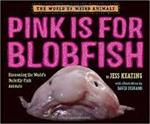 Think pink is just for princesses? Think again! This fascinating nonfiction picture book introduces readers to 17 unique pink animals from around the world, including aquatic animals like the blobfish and pygmy seahorses and terrestrial animals like pink land iguanas and pinktoe tarantulas. Each two-page spread features a full-page photograph of the animal, a short introductory paragraph, and a sidebar identifying common name, species name, size, diet, habitat, and predators/threats. Further, a fun fact is included for each animal along with a cartoon. Back matter contains a world map indicating where to find each animal, a glossary, and a short list of additional resources for readers who want to learn more about these perfectly pink animals.
Think pink is just for princesses? Think again! This fascinating nonfiction picture book introduces readers to 17 unique pink animals from around the world, including aquatic animals like the blobfish and pygmy seahorses and terrestrial animals like pink land iguanas and pinktoe tarantulas. Each two-page spread features a full-page photograph of the animal, a short introductory paragraph, and a sidebar identifying common name, species name, size, diet, habitat, and predators/threats. Further, a fun fact is included for each animal along with a cartoon. Back matter contains a world map indicating where to find each animal, a glossary, and a short list of additional resources for readers who want to learn more about these perfectly pink animals.
The Tree in the Courtyard: Looking Through Anne Frank’s Window. Jeff Gottesfeld. Ill. Peter McCarty. 2016. Alfred A. Knopf/Random House.
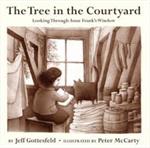 This picture book is told from the perspective of the horse chestnut tree outside of Anne Frank's attic window during World War II before Anne and her family were discovered and taken to a concentration camp. When the horse chestnut tree died, saplings grown from its seedpods were sent to a variety of locations including New York City, at the site where the twin towers of the World Trade Center once stood. McCarty’s intricate brown ink drawings add a sense of somberness to this tale. This is a worthy companion text for middle-grade readers who may have learned about Anne Frank in school. An extended author’s note provides more context for the reader and gives information about how saplings from this tree have been sent all over the world.
This picture book is told from the perspective of the horse chestnut tree outside of Anne Frank's attic window during World War II before Anne and her family were discovered and taken to a concentration camp. When the horse chestnut tree died, saplings grown from its seedpods were sent to a variety of locations including New York City, at the site where the twin towers of the World Trade Center once stood. McCarty’s intricate brown ink drawings add a sense of somberness to this tale. This is a worthy companion text for middle-grade readers who may have learned about Anne Frank in school. An extended author’s note provides more context for the reader and gives information about how saplings from this tree have been sent all over the world.
The Wild Robot. Peter Brown. 2016. Little, Brown.
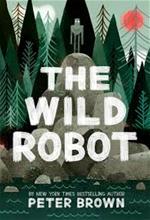 When Roz the Robot is activated for the first time, she finds herself on a remote island with only wild animals inhabiting the area. Although rejected by the animals at first for being a “monster,” Roz quickly wins them over with her robot skills and charm, and soon they are treating her more like a friend and less like an outsider. Brown’s first venture into writing chapter books for middle-grade readers is a delightful tale of friendship, acceptance, and making tough decisions. His cartoon-style illustrations in black and white are interspersed throughout the text. In “A Note About the Story,” Brown tells how he came to write this “robot nature story.” A great pick for readers who dream of adventure—and robots.
When Roz the Robot is activated for the first time, she finds herself on a remote island with only wild animals inhabiting the area. Although rejected by the animals at first for being a “monster,” Roz quickly wins them over with her robot skills and charm, and soon they are treating her more like a friend and less like an outsider. Brown’s first venture into writing chapter books for middle-grade readers is a delightful tale of friendship, acceptance, and making tough decisions. His cartoon-style illustrations in black and white are interspersed throughout the text. In “A Note About the Story,” Brown tells how he came to write this “robot nature story.” A great pick for readers who dream of adventure—and robots.
Ages 12–14
Lily and Dunkin. Donna Gephart. 2016. Delacorte/Random House.
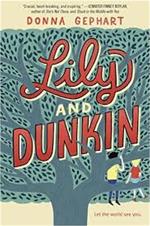 Timothy McGrother knows in his heart that he is a girl and that his name should be Lily. He longs to wear dresses and do “girl things” with his big sister, Sarah. Norbert (“Dunkin”) Dorfman, who suffers from bipolar disorder, has just moved to Lily’s Florida neighborhood after a painful family event. He’d like to be friends with Lily, but he also longs to fit in with the basketball team. Told in alternating chapters from Lily’s and Dunkin’s points of view, this story of friendship and finding your true self is a wonderful middle-grade novel that doesn't shy away from tough topics.
Timothy McGrother knows in his heart that he is a girl and that his name should be Lily. He longs to wear dresses and do “girl things” with his big sister, Sarah. Norbert (“Dunkin”) Dorfman, who suffers from bipolar disorder, has just moved to Lily’s Florida neighborhood after a painful family event. He’d like to be friends with Lily, but he also longs to fit in with the basketball team. Told in alternating chapters from Lily’s and Dunkin’s points of view, this story of friendship and finding your true self is a wonderful middle-grade novel that doesn't shy away from tough topics.
Super Gear: Nanotechnology and Sports Team Up. Jennifer Swanson. 2016. Charlesbridge.
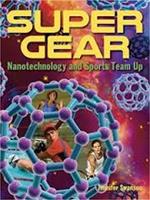 What exactly is nanotechnology, and how does it relate to sports? In this nonfiction book, Swanson takes an in-depth look at how nanotechnology scientists and engineers are changing the face of athletics in the 21st century by designing better running shoes, tennis rackets, swimsuits, and other sports-related equipment. This reader-friendly introduction to nanotechnology breaks down the science and describes the processes of nanomanufacturing in a clear and understandable way. Packed with photographs, diagrams, and text boxes, this book will appeal to athletes and sports enthusiasts—and the curious. Back matter has an author’s note, glossary, resources (books and websites), source notes, a lengthy bibliography, and an index.
What exactly is nanotechnology, and how does it relate to sports? In this nonfiction book, Swanson takes an in-depth look at how nanotechnology scientists and engineers are changing the face of athletics in the 21st century by designing better running shoes, tennis rackets, swimsuits, and other sports-related equipment. This reader-friendly introduction to nanotechnology breaks down the science and describes the processes of nanomanufacturing in a clear and understandable way. Packed with photographs, diagrams, and text boxes, this book will appeal to athletes and sports enthusiasts—and the curious. Back matter has an author’s note, glossary, resources (books and websites), source notes, a lengthy bibliography, and an index.
Ages 15+
Doping in Sports: Winning at Any Cost. Stephanie Sammartino McPherson. 2016. Twenty-First Century.
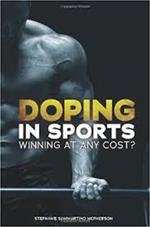 Teens are bombarded with messages to “just say no” to drugs, yet every year another professional athlete is outed for saying yes. This nonfiction account tackles the important topic of doping or using performance enhancing drugs (PEDs) in athletes at all levels—from high school to the pros. McPherson offers a historical perspective on the development and use of PEDs interspersed with many vignettes of athletes from a variety of different sports. Back matter includes a timeline, detailed source notes, a glossary, an index, and additional resources to complement the information in the text.
Teens are bombarded with messages to “just say no” to drugs, yet every year another professional athlete is outed for saying yes. This nonfiction account tackles the important topic of doping or using performance enhancing drugs (PEDs) in athletes at all levels—from high school to the pros. McPherson offers a historical perspective on the development and use of PEDs interspersed with many vignettes of athletes from a variety of different sports. Back matter includes a timeline, detailed source notes, a glossary, an index, and additional resources to complement the information in the text.
The Great American Whatever. Tim Federle. 2016. Simon & Schuster.
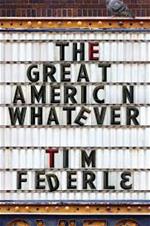 Sixteen-year-old screenwriter-wannabe Quinn Roberts is dealing with some tough issues: His sister was killed in a car accident; his single-parent mom is having a hard time coping with life, not to mention the bills that are piling up; and he’s trying to figure out how to tell his mom and best friend that he’s gay. This coming-of-age story, told with Federle’s humorous and sometimes sarcastic voice, explores themes of living through loss, friendship, and first romance and should appeal especially to teen readers who are trying to find their way in life.
Sixteen-year-old screenwriter-wannabe Quinn Roberts is dealing with some tough issues: His sister was killed in a car accident; his single-parent mom is having a hard time coping with life, not to mention the bills that are piling up; and he’s trying to figure out how to tell his mom and best friend that he’s gay. This coming-of-age story, told with Federle’s humorous and sometimes sarcastic voice, explores themes of living through loss, friendship, and first romance and should appeal especially to teen readers who are trying to find their way in life.
Jennifer W. Shettel is an associate professor at Millersville University of PA, where she teaches undergraduate and graduate course in literacy for preservice and practicing teachers. Prior to joining the faculty at Millersville, she spent 16 years as an elementary classroom teacher and reading specialist in the public schools.
These reviews are submitted by members of the International Literacy Association's Children's Literature and Reading Special Interest Group (CL/R SIG) and are published weekly on Literacy Daily.